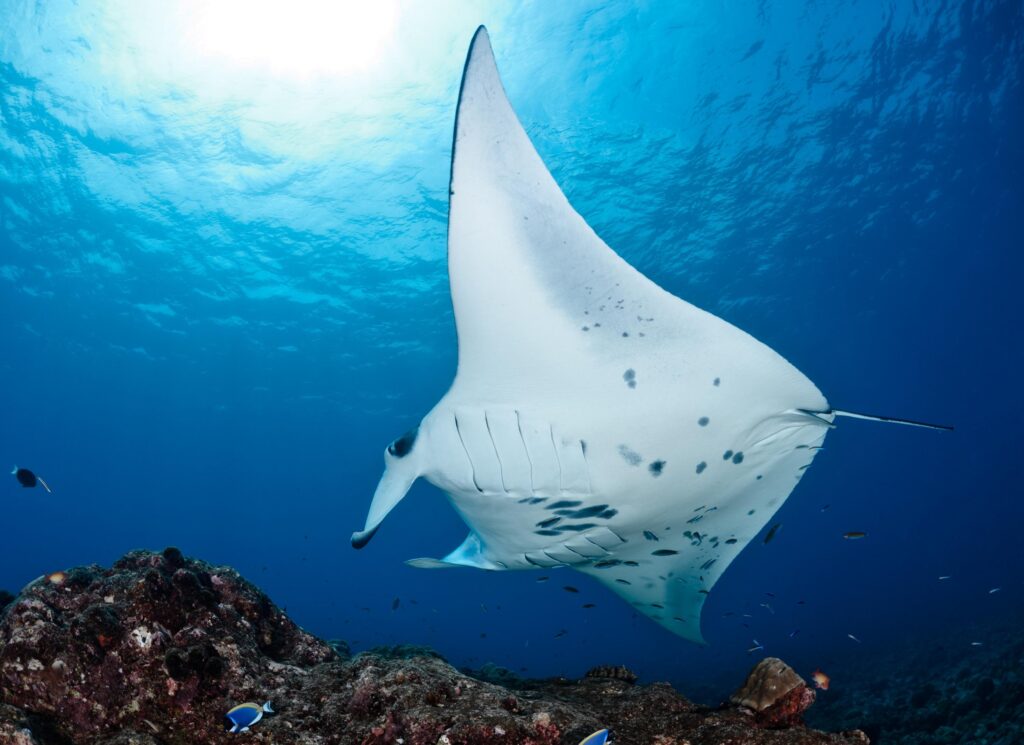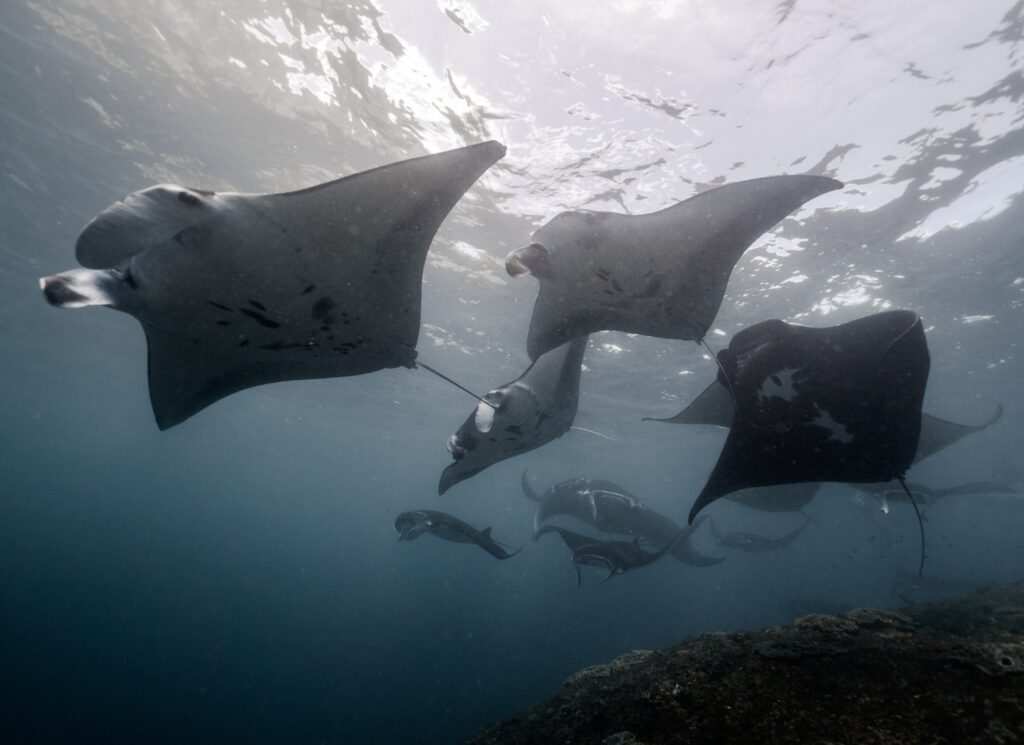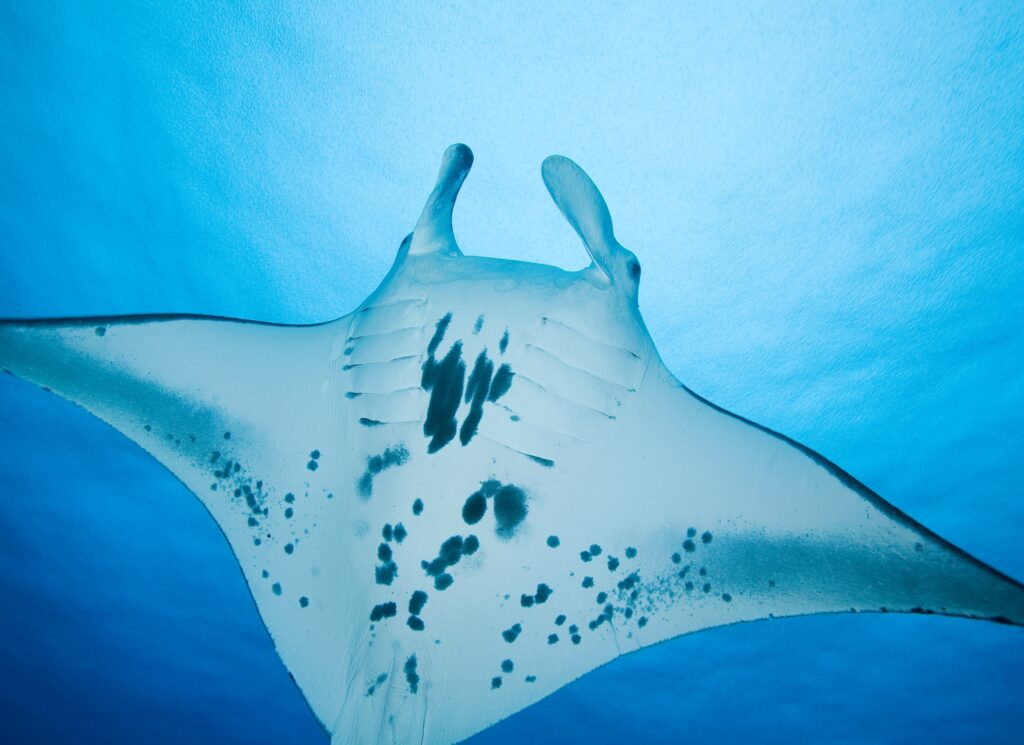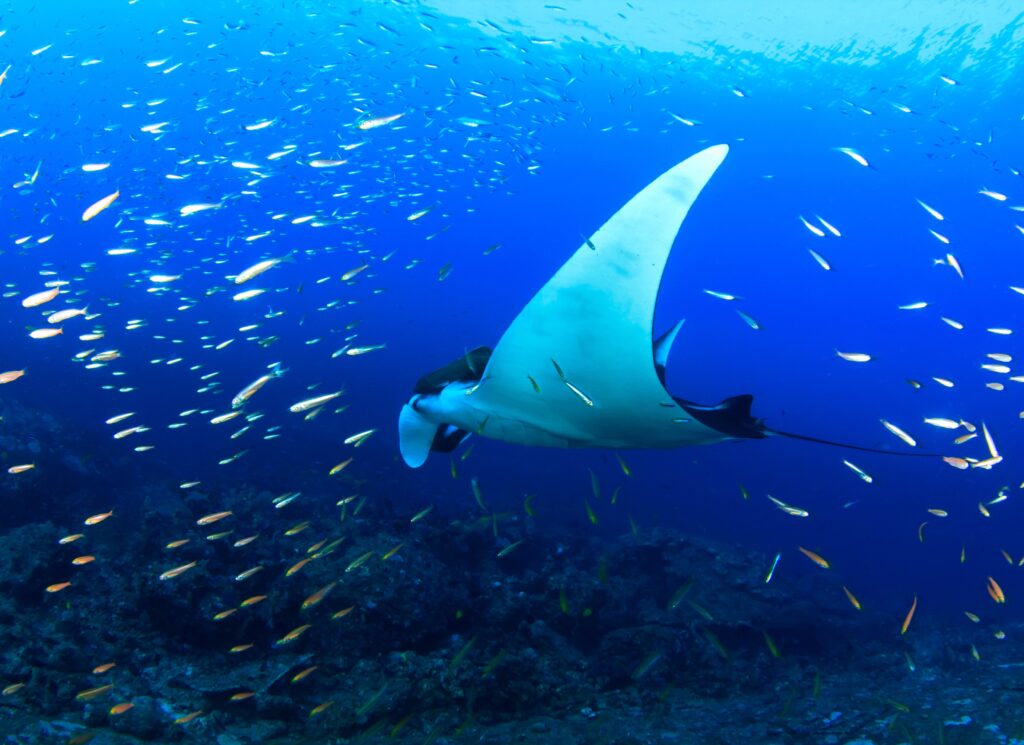Travelers from around the world seek out Komodo Island in Indonesia to observe the largest, oldest and most dangerous lizard, the Komodo Dragon. Similarly, scuba divers seek out Indonesia for life under the sea: most notably manta rays in Komodo. In fact, Indonesia is ranked second in the world for manta ray tourism.
If you’ve been lucky enough to observe reef manta rays on a scuba dive or snorkeling tour, you may have noticed that they are extremely curious and playful. In Komodo National Park, it’s common for them to swim right up to divers on the reef or even play with divers’ bubbles.
This blog post will explore manta rays and their growing population in Komodo National Park. Keep reading for everything you need to know about manta rays in Komodo! And if you’re ready to join us on a dive to see these beautiful creatures in action, click here to contact the Azul Komodo dive center in Labuan Bajo.

Facts About Manta Rays in Komodo National Park
How Intelligent are Manta Rays?
Scientists estimate intelligence in marine life using two distinctions: brain mass and brain size relative to the animal’s body. Manta rays measure well on this scale since they have the largest brains of any fish. Like humans and elephants, the manta ray has a proportionally larger brain than the rest of its body. This indicates a high evolutionary investment in brain function and allows researchers to conclude that manta rays have greater intelligence than most marine organisms.
Many researchers believe that manta rays are capable of recognition – and not only self-recognition at that. When presented with a mirror, manta rays behave unusually. They often repeat motions like humans make when “preening” themselves.
Their high level of curiosity, tendency to revisit the best cleaning stations, and the fact that they actively solicit help when tangled in fishing lines or other debris also indicate a higher level of brain function and activity.
Source: https://www.npr.org/2022/08/15/1117557898/ode-to-the-manta-ray

Captivating Courtship Dance and Mating Rituals at Cleaning Stations
A new report detailing data over the last 14 years offers a novel, in-depth look at the mating rituals of manta rays. Although giant manta rays and reef manta rays vary significantly in terms of habitat and time of mating, they are very similar in mating rituals.
First, a female manta ray releases pheromones that draw the attention of male rays in the vicinity. However, when a male moves in, she darts off into the blue, sometimes initiating an hours-long chase that may involve more than one male. Researchers believe that the female manta rays behave this way to draw the attention of as many males as possible, therefore giving them a larger variety of mating choices.
These are called “courtship trains” and are often observed near cleaning stations. If the female manta ray is satisfied with the last remaining suitor, they’ll swim to the surface and mate.
Source: https://hakaimagazine.com/news/watch-the-captivating-courtship-dance-of-manta-rays/

What is a Manta Ray’s Ideal Habitat?
Now that we’ve covered intelligence and mating rituals, let’s touch on the manta ray’s ideal habitat. Although you can technically find manta rays in all oceans on Earth, they prefer tropical and subtropical temperatures. This reason is why manta rays thrive in Komodo!
The giant manta ray is pelagic. This means that they prefer to live in the open ocean far away from the bottom or the shoreline. Alternatively, reef manta rays like living in shallower waters near groups of islands, bays and seamounts. Manta Rays are often spotted from the surface or at shallow depths of 5-7 meters. This is why these creatures are commonly seen on Discovery Dives or Open Water first-time diving trips!
Manta rays are so common in Komodo National Park because our plankton-rich waters provide plenty of options for cleaning stations, feeding sites and a large population for mating. One study found that individual manta rays in Komodo showed their unique preferences for specific dive sites in the area!
Source: https://www.mantaray-world.com/manta-ray-habitat/

Size, Color and Unique Markings of Manta Rays in Komodo
Reef mantas, the smaller of the two manta ray species, typically have a wingspan of around 3-5 meters. The wingspan of giant manta rays, the largest rays in the ocean, can reach a whopping 7 meters. Not only are manta rays big, but they are dense. They can weigh up to two tonnes!
When it comes to colors and markings, there are two possibilities. The first is a black or dark gray back with a white underbelly, pictured below. The second is almost completely black with white patterns on their bellies. The pattern on their stomach is 100% unique to each manta ray, much like a human’s fingerprint.
Source: https://www.dresseldivers.com/blog/manta-ray-facts/

Population Growth of Manta Rays in Komodo Makes Researchers Hopeful for the Future
In a new study in May of 2022, scientists from the Marine Megafauna Foundation and Murdoch University observed an aggregation of 1,085 reef mantas in Komodo National Park. Illegal fishing activity and getting tangled in marine debris have classified reef manta rays as a vulnerable species, but they have found a safe haven in our UNESCO World Heritage Site.
Results of the study indicate that, in all probability, researchers have not yet identified all the reef mantas currently residing in KNP. The total number is likely much higher than 1,085. Manta rays are attracted to Komodo because of the plankton-rich waters, abundance of cleaning stations, mating possibilities and feeding grounds.
Experts on the matter hypothesize that manta-rich sites like Komodo National Park will play an integral part in safeguarding reef mantas from extinction.
The Labuan Bajo Dive Community Steps in to Help
Researchers teamed up with the Labuan Bajo dive community to request identification photographs of reef mantas and submit them to MantaMatcher.org. During the collaboration, lead author on the study, Dr. Elitza Germanov stated, “I was amazed by how receptive the local dive community was in helping collect much needed data on these threatened animals.”
After years of embarking on dives and appreciating first-hand the beauty of Labuan Bajo and Komodo, Azul Komodo is committed to protecting our marine environment and the species that call it home. When visiting Komodo National Park, your number one priority should be to leave things even better than you found them. That’s why we partner with amazing organizations like Trash Hero and Green Fins, as well as keep our office and dive boat free of single-use plastics. We offer reef-safe sunscreen and biodegradable soap to our customers and make sure to serve freshly made and locally sourced vegetarian food to lessen our environmental impact. Long story short – we’ll do anything to protect the natural beauty of Komodo so it remains a safe haven for reef mantas and many other marine species for years to come.
Sources: https://news.mongabay.com/2022/05/for-reef-mantas-indonesias-komodo-national-park-is-a-ray-of-hope/ and https://peerj.com/blog/post/115284885731/author-interview-komodo-national-park-is-home-to-some-of-the-worlds-largest-manta-ray-aggregations/

The Best Dive Sites to Find Manta Rays in Komodo National Park
One thing we’ve learned during our years scuba diving in Komodo National Park is that people love manta rays! Scuba divers and snorkelers travel to Indonesia from all corners of the world to observe these magical creatures feeding, playing and cleaning in their natural habitat.
Is your goal to swim with the mantas in Komodo National Park? Our experienced team knows the best spots in Komodo to observe manta rays on dives. Even better? You don’t need to embark on a liveaboard to do it! These dive sites are only a day trip away.
The best dive sites to see manta rays do vary slightly by season. However, Taka Makassar (Manta Point), Mawan and The Cauldron usually yield significant manta rays sightings year-round. When you book your next dives with Azul Komodo, be sure to mention to your dive instructor that manta rays are on your marine life bucket list. We’ll do our best to make it happen!

We hope you enjoyed this guide to reef manta rays in Komodo National Park. Make sure to follow along for the adventure on Instagram @azul.komodo for more scuba diving content in KNP.